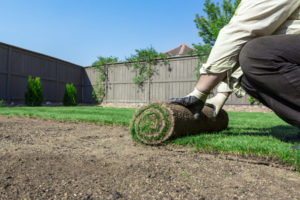
Whether you’re a new first-time sod owner or looking to improve the health of your Zoysia sod, here are some tips to get your yard looking its best.
Zoysia sod has become an increasingly popular choice for lawns these days, with its low-maintenance nature, capacity to thrive in ranging climates, and verdant good looks.
Whether you’re a new first-time sod owner or looking to improve the health of your long-loved Zoysia lawn, we’ve got some springtime-fresh tips sure to get your yard looking its springtime-best. So, read along below for an (intellectual) watering of that greatest living organism of all—your mind! (…Yes, reader, yours!)
Planting Protocol
When planting new zoysia lawns, most landscapers opt for pre-grown plugs or sod due to the strand’s relatively slow growth from seed. If using seeds (-in, perhaps, some admirably willful albeit misguided assertion-via-action that the easy route is always tantamount in a moral sense to “the low road”), expect germination to take at least three weeks, and plan to wait up to about a year for the lawn to fully establish.
After that, any still-remaining bare spots in the lawn will naturally fill in as zoysia gradually spreads through stolons and rhizomes—which, of course, you know what those are; we’ll skip the superfluous expounding. -And in any event, sod is the way to go.
Proper Mowing Height
Maintaining the correct mowing height is crucial for both healthy zoysia sod and the uncompromised structural integrity of human feet. Aim to keep your lawn between one and three inches tall, adjusting mowing frequency based on seasonal growth.
Sharp mower blades are essential for cutting through dense turf, so make sure to… y’know… sharpen them regularly. This’ll ensure the prevention of uneven lawn cuts and clippings, and having a professional do the sharpening will prevent uneven cuts and clippings on you.
Thatch Removal
Alas! Subject as all things to time’s (illusory?) passage, zoysia turf eventually develops a stubborn layer of thatch—which is a darn shame, as this hinders the penetration of nutrients, water, and air into the soil. But don’t give in to despair just yet!: you can prevent thatch buildup using a trusty mechanical de-thatcher or a de-thatching rake, and you only need to do so once or twice a year.
Collect and dispose of removed thatch like you would any yard trimmings, assuming (which we do assume, noble reader) that your disposal methods are in accord with all state/federal laws, local ordinances, what Mr. Rogers would non-judgmentally expect of you, HOA regulations, etc.
Aeration
To fend off the dread scourge of soil compaction—thereby ensuring proper airflow and nutrient absorption—aerating your zoysia lawn is another m-u-s-t. For this, you’ll have to rent an aerator or borrow one from a neighbor both exceptionally resourceful and kindly, whom it may then be nice (though by no means on their part “expected” of you) to express gratitude toward with, say, baked goods. Evenly aerate your yard after the last spring freeze, then wait two or three weeks before applying pre-emergent herbicides or fertilizer to the lawn.
Fertilization
Regular fertilization is key, yielding vital nutrients for your zoysia sod. Test your soil using an at-home soil test if you’re a pretty serious yard hobbyist or looking to became one; otherwise, consult your local lawncare pro for a comprehensive report on soil nutrient levels and the subsequent advice on what their findings indicate needs doin’. Fertilize first in early spring, ideally (in this case as well) around that last seasonal frost, and then every six to eight weeks throughout growing season. An application or two in early fall is always advisable, too.
Remember that zoysia grass typically requires between two and four pounds of nitrogen per 1,000 square feet per year, so select a fertilizer—or consult an expert for assistance—accordingly.
Watering
Zoysia grass thrives with approximately an inch of water to drink, as it were, per week. If rainfall is persistently insufficient, use a sprinkler weekly to make up the difference, preferably in the morning. This allows the turf to dry gradually throughout the day, reducing the risk of fungal diseases. Beware that overwatering will cause pooling, fungus, and generally unhappy zoysia.
Weed/Disease Control
The dense nature of zoysia turf naturally inhibits weed growth, but… weed seeds are just as naturally persistent and may still find their way into your lawn. -Advisable to apply some handy-dandy pre-emergent herbicide right after—you guessed it—the last frost of spring. Follow up with a post-emergent herbicide for any weeds that have the (relative) luck and audacity to persist.
Zoysia is susceptible to diseases like brown patch and dollar spot—hey, we’re none of us perfect—so do consider applying a preventative fungicide as well.
Pest Management
In warm climates, zoysia lawns can attract pests like mole crickets, grubs, and (brace yourself!:) nematodes. Apply an insecticide specifically labeled for whatever pests you’ve noticed or battled in seasons past.
For grubs in particular, milky spore is a commonly used treatment, although this method can take several years to fully eradicate the grubby little sod-munchers from your lawn.
For faster results, happier zoysia sod, and anything else you could possibly need to make your yard the unquestioned bell of the neighborhood ball, remember that highly skilled lawncare specialists are always just a quick phone call or email away.
Get Your Yard Ready for Spring
Order early and order often to ensure the best service possible. Contact us through our online page. Please find us at 27616 Little Lane, Salisbury, Maryland 21801. Our phone number is 410-726-6103, and our fax number is 410-742-6550. Speak to Jason Anderson for Turf Grass Sales. Reach him by email at jason@quanticocreeksod.com. Finally, follow us on social media on Facebook, LinkedIn, and our blog!
